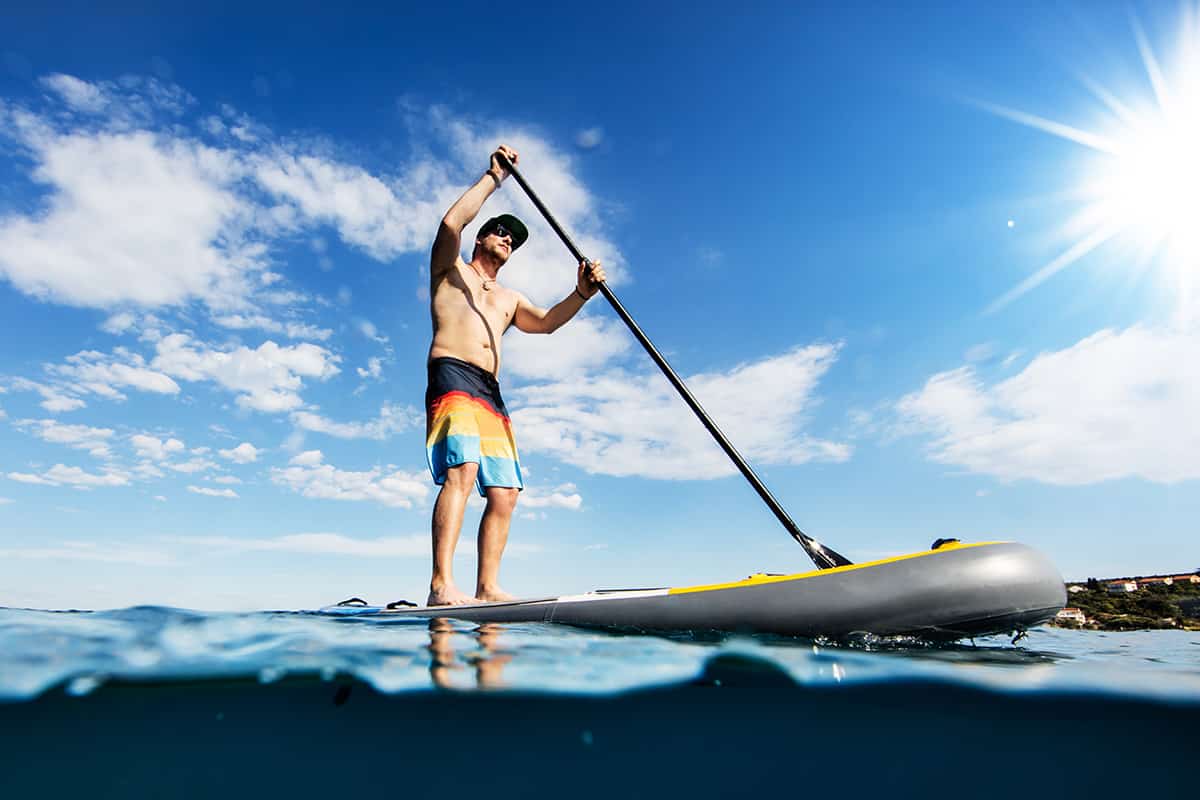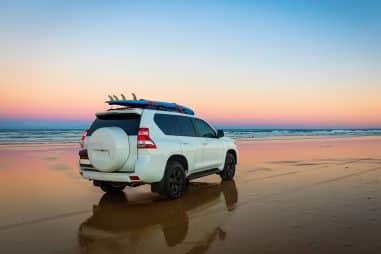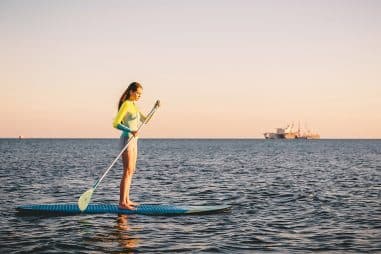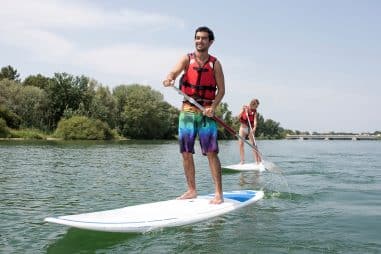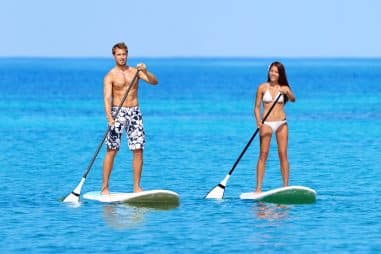The question is, how long will those speeds be sustainable. It stands to reason that those speeds will drop down once the distances go farther. Racers usually tail off at an average of 8-11 kph (5-6.8 mph). How long this speed can be sustained over a period of time all depends on the athlete’s fitness.
How Fast Is a Paddle Board?
How fast can paddle boards go has no hard and fast answer. A lot of factors go into it. But for those of you who have a head for numbers, here you go. Pro racers can sustain a speed of up to 8 mph, while amateurs’ average speed on a good day is in the neighborhood of 4 mph. So now, let’s see what influences a paddle board’s speed.
- First, how fit are you? Of course, it goes without saying that the fitter you are, the more equipped you are to paddle faster and for longer periods of time.
- Next is what type of board you are using: You get better performance when you use a racing board as compared to a touring board or an all-around board. And then there’s the choice of using an inflatable or a hard board. Again, your choice will affect your speed.
- What’s the wind speed and direction? If you paddle downwind, you will go faster, while paddling upwind will slow you down to a crawl if you can make any headway at all. And having crosswind is another story where the wind blows you off course.
- What are the water conditions? Is it choppy, rough, or calm? Is it deep or shallow? Is the water clean or all mucked up? Is there a current or none at all? All of these factors will affect your speed either to speed you up or slow you down.
- Then, of course there’s the question of how far you are traveling: You may be able to paddle faster for a short period but will not be able to sustain for a more extended period; therefore, your average speed goes down.
What Makes a Paddle Board Fast?
Several things can make a paddle board fast. One is what type of paddle board it is. If it’s a racing paddle board, then you can expect it to be faster than the beginner or touring board. The material of your board also influences a paddle board’s speed. For example, a hardshell racing paddle board will go a bit faster than an inflatable racing paddle board.
However, the most crucial factor of making a paddle board go faster is the paddler himself. All things being equal, it’s the paddler’s skill that will make a board go faster than another one of the same types.
Are Longer Paddle Boards Faster?
Yes, longer and narrower (emphasis on narrower) paddle boards are faster than other types of board. Racing paddle boards are built this way for a reason. A narrow board has less surface area in contact with water and therefore has a lesser drag. It also presents a smaller head-on profile to the water, which means less resistance to water progression. Narrower boards also accelerate more quickly and therefore require less energy spent from the rider.
You must be able to maintain your balance while retaining your paddling stroke to get the full benefit of the narrower board. In addition, you have to get your weight off the board and into the paddle, so your board sits higher in the water and therefore further lessens its wetted area. Again, this means improving your technique and fitness to cope with the demand for a narrower board.
How Can I Make My Paddle Board Faster?
How to make your board go faster? First, you have to improve your paddling technique to get the most out of your strokes. Focus on extending your reach instead of taking more quickly, shorter strokes. Get your whole body into the stroke and not just your arms. Learn to get the timing of your stroke and add the power at the middle of your stroke. Needless to say, you need to improve your fitness to be able to do all these things.
Shifting to a paddle board designed for speed (if you haven’t already) will definitely boost your need for speed. These are the SUPs that have a longer, narrower design, as discussed above. Get the right-sized board for your weight, and it will do wonders for your paddle boarding success.
How Long Does It Take to Paddle Board a Mile?
That depends on whether you are paddle boarding leisurely or racing. The time it will take you to paddle board a mile on average is around 15 minutes. This is using either a hard or inflatable paddle board. The hard paddle board is slightly faster than the inflatable one, but the difference is not that significant if you are paddle boarding at a relaxed pace.
If you are paddling at a fast pace, the inflatable paddle board can complete a mile in about 13 minutes. The hard paddle board can do it in about a minute or less, 12 minutes. Not a really substantial difference unless it’s in a race. Then it becomes a considerable difference.
How Long Does It Take to Paddle Board 3 Miles?
Serious amateurs can paddle 3 miles in 30 minutes on a good day. If you are in decent shape, this is doable. But if you are paddling leisurely and just smelling the roses as you go, this could take an hour. It all depends on the type of paddling you are aiming for.
Actually, 3 miles in an hour is par for the course for a laid-back outing. But, if you’re paddling just to clear your mind and get some sun, this unhurried pace will be just what the doctor ordered.
How Long Does It Take to Paddle Board 5 Miles?
90 minutes. That’s how long it takes to paddle board 5 miles for avid non-professionals. This is assuming fair weather without any major issues. This does not take into account what type of board one is using, but this time comes from a number of enthusiasts’ experiences.
This time is for those who are determined to get in some significant workout. This is not so fast that you can expend yourself out early and not so slow so that you get some serious burn doing it.
How Long Does It Take to Paddle Board 10 Miles?
3.5 – 4 hours. As we have mentioned here before, the farther you go on your paddle board, the slower your average rate of speed will be. This is due to fatigue setting in after all those hours of paddling. You might also need to take a break and replenish your strength by getting some snacks at this time.
Your fitness now counts for more in this scenario. A longer paddling time means you have to have the stamina to keep up the pace. So you need to be physically ready if you are planning to go this far. You also need to keep track of the weather conditions, so you don’t get caught unaware when you are a bit far from your starting point.
How Far Can You Paddle Board in a Day?
This is tricky. Let’s assume that you have been paddling for a sufficient amount of time already and you’re familiar with your equipment. Let’s list down all of the elements that go with paddle boarding in one day, supposing a day is 8 hours.
- Where are you paddling? Is it going to be in a fast-moving river with tree branches floating in it, a placid lake or a choppy sea?
- How’s the weather? Is the wind blowing at your back or in front of you? Is it raining or is the weather clear and sunny?
- What type of paddle board are you on? Is it a racing or an all-around paddle board?
- What stuff are you bringing with you for an all-day trip? You need to bring water, food, maybe a change of clothes, etc., that will add to the weight you are carrying on your board.
- How’s your physical condition? Are you up for paddling continuously, or would you need to take some breaks? You know, sit down for few minutes and just let the current take over.
- How much effort do you want to put in your paddling? Do you want to go all-out, or you want to take it easy? Pushing it may actually affect your overall speed negatively. You may not be able to maintain a faster pace, so you may need to take more frequent and longer breaks. A slower sustainable pace would be more desirable.
- Are you paddling with somebody else or even a group? Again, this could impact your speed. If people in your group paddles slower than you, then you have to adapt to that pace. Or you might have trouble keeping up, so they adapt to you. Either way, traveling with a group affects your time.
So, to answer the question, it depends on all the above factors. But, on average, a slow leisurely outing going at 3 miles per hour, with maybe four 15-minute breaks to rest and have something to eat, you could travel around 21 miles in an 8-hour trip.

